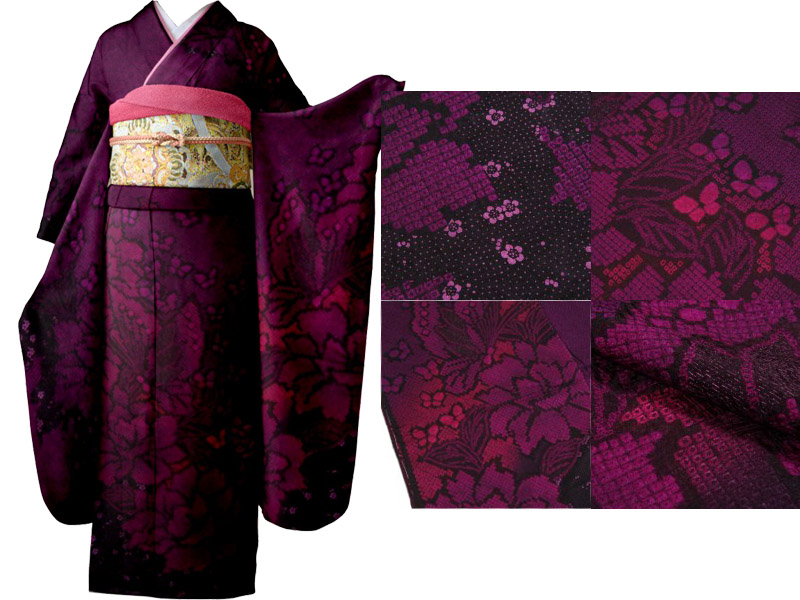和服漫谈
The kimono is a Japanese traditional garment worn by women, men and children. The word “kimono”which literally means a “thing to wear” (ki "wear and mono “thing”),has come to denote these full-length robes. Kimonos made with exceptional skill from fine materials have been regarded as great works of art.
和服是日本男女老少所穿着的传统服装。“和服”字面上的意思 是“穿的东西”(ki是“穿”,mono是“东西”),用来表述这种长袍。材料精美、做功精细的和服被视为艺术品
Today, kimonos are most often worn by women, and on special occasions. Traditionally, unmarried women wore a style of kimono called furisode, with almost floor-length sleeves, on special occasions. A few older women and even fewer men still wear the kimono on a daily basis. Men wear the kimono most often at weddings, tea ceremonies, and other very special or very formal occasions. Professional sumo wrestlers are often seen in the kimono because they are required to wear traditional Japanese dress whenever appearing in public.
如今,和服大多是女性在特殊场合里才会穿的服装。传统上,未婚女性在特殊场合穿着称为振袖的和服,这种和服有着几乎及地的长袖。一些老年妇女,甚至为数更少的男子仍然每天穿着和服。男子大多在婚礼、茶道和其他非常特殊或非常正式的场合才穿和服。我们经常看到职业相扑选手穿和服,那是因为他们被要求在公共场合出现时必须穿着日本传统服装。
As the kimono has another name gofuku, the earliest kimonos were heavily influenced by traditional Han Chinese clothing, known today as faanfu, through Japanese embassies to China which resulted in extensive Chinese culture adoptions by Japan, as early as the fifth century. It was during the 8th century, however, when Chinese fashions eame into style among the Japanese, and Ae overlapping collar became particularfy a women、fashion. During Japan's Heian period (794—1192), the kimono became increasingly stylized, though one still wore a half-apron, called a mo, over it. During the Muromachi age (1392_1573), the Kosade, a single kimono formerly considered underwear, began to be worn without the hakama pants over it, and thus began to be held closed by an obi “belt”. During the Edo period (1603—1867), the sleeves began to grow in length, especially among unmarried women, and the Obi became wider, with various styles of tying coming into fashion. Since then, the basic shape of both the men’s and women’s kimono has remained essentially unchanged.
从和服的别名吴服可知,早期和服深受传统汉族服装(即今天的汉服)的影响。早在5世纪,日本就开始大量吸收这种由遣唐使者带回的中国文化。然而,这种中国服装在8世纪才开始在日本流行起来,尤其是交领成为妇女的时尚。在日本平安时代(794-1192年〉,和服日益形成自己的风格,但仍有一个称为裳的半裙。在室町时代 (1392-1573年),人们开始穿过去被当成衬衣的小袖,不再在其外面穿和服裙裤,而开始改用宽腰带来束缚。在江户时代(1603-1867 年),袖子变得更长(特别是未婚妇女),腰带变得更宽,各种系法变成了时尚。自那时起,男式和女式和服的样式基本定型。
The formal Kimono was replaced by the more convenient Western clothes and Yukata as everyday wear. After an edict by Emperor Meiji, police, railroad men and teachers moved to Western clothes. The Western clothes became the anny and school uniform for boys. After the 1923 Great Kanto earthquake, Kimono wearers often became victims of robbery. The Tokyo Women’s & Children’s Wear Manufacturers' Association promoted the western clothes. Between 1920 and 1930 the Sailor outfit replaced the undivided hakama in school uniform for girls. The 1932 fire at Shirokiya’s Nihombashi store is said to have been the catalyst for the decline in kimonos as everyday wear. The national uniform, Gokumin-fuku, a type of western clothes was mandated for males in 1940. Today people often wear western clothes, and wear the easier to wear, cool and comfortable Yukata in special time.

正式的和服作为日常穿着的地位,被更为便捷的西服和浴衣所取代。在明治天皇颁布一项法令后,警察、铁路工人和教师开始改穿西服。西服成为军队和学校男子的制服。在1923年的关东大地震后,穿着和服的人往往成为被抢劫的对象。东京妇女和儿童服装制造商协会推动了西服的普及。1920到1930年间,水手服取代不可分割的和服裙裤,成为女生的校服。1932年,Shirokiya的 Nihombashi店的火灾被认为是造成和服在日常生活中的使用下降的催化剂。1940年,男子被要求穿全国性的制服国民服,这是西服的一种。今天,人们通常穿西服,在特殊场合穿更容易穿着更凉爽和舒适的浴衣。
A woman’s kimono may easily exceed US$ 10,000; a complete kimono outfit, with kimono, undergarments, obi, ties, socks, sandals and accessories, can exceed US$ 20,000. A single obi may cost several thousand dollars. However, most kimonos owned by kimono hobbyists or by practitioners of traditional arts are far less expensive. Enterprising people make their own kimono and undergarments by following a standard pattern, or by recycling older kimonos. Cheaper and machine-made fabrics can substitute for the traditional hand-dyed silk. There is also a thriving business in Japan for secondhand kimonos, which can cost as little as ¥ 500. Women's obis, however, mostly remain an expensive item. Although simple patterned or plain colored ones can cost as little as ¥ 1,500, even a used obi can cost hundreds of dollars, and experienced craftsmanship is required to make them. Men’s obis, even those made from silk, tend to be much less expensive, because they are narrower, shorter and less decorative than those worn by women.
女式和服的价格超过1万美元很正常,一套完整的和服包括和服、衬衣、宽腰带、带子、袜子、木屐和其他装饰品,价格可超过2万美元。光一个宽腰带都要好几千美元。然而,大多数和服爱好者或者传统艺术工作者所拥有的和服远没有那么贵。有创业精神的人自己按标准模板或通过回收利用旧和服来制作和服和衬衣。相对更便宜的机器制造面料可以替代传统的手工印染丝绸。日本还有繁荣的二手和服业,一套和服可低至500人民币。然而,女性的宽腰带大多数还是很昂贵。虽然图案简单或纯色的和服可低至1500人民币,但即使是一条二手宽腰带都要几百美元,而且需要有经验的师傅来制作。然而,男子的宽腰带即使是丝绸做的也远没那么贵,因为他们比女式的更窄、更短、装饰更少。













